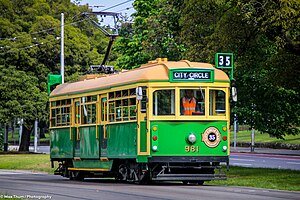Commission of Lendert Transport
| Commission overview | |
|---|---|
| Formed | June 27th, 1953 |
| Headquarters | Transport House, Calunny Street |
| Chairman | Sir Henry Frankman |
The Commission of Lendert Transport is the body responsible for public transport in Lendert-with-Cadell and Greater Lendert constituted by the Sessions Court of Lendert and Cadell. The Chairman Commissioner is currently Sir Henry Frankman, K.H., who was appointed to the position in 2019. The Commission has responsibilities and powers over private railway, tramway, omnibus and waterboat public transport companies throughout the the Greater Lendert area, encompassing the Cities of Lendert-with-Cadell as well as the hundreds of Plarshed, Manstole, Clementsfield, High Havage-with-Galwick, and Offbank.
History
The Commission of Lendert Transport was formed in 1952 by the City Corporation to facilitate the unification of railway, tramway and omnibus services in Lendert and surrounds, services hitherto having been disparate and ad hoc such that no clear network could be determined. Originally it was proposed that the City and Counties Railway, along with the numerous tramway and omnibus companies would be acquired by the City Corporation, to be run by the Commission; however, this faced stiff opposition from the companies and legal challenge from the Government as over-stepping the role of the Corporation.
Ultimately, the Commission merely took over by warrant to the City Corporation certain rights of regulation already subsisting in the Crown for railways within the Cities of Lendert and Cadell. It also took powers of railway control delegated by the Board of Railways for railways in Greater Lendert, and omnibus and tramway control within the Cities delegated by the Compagnie of Carriagemen. Control of omnibus and tramways in Greater Lendert was acquired by vote of the Sessions of Lendert, under the Greater Lendert Act in 1955.
The Commission set the initial task of designing a unified livery for railway, tramway and omnibus services. A design based on the company colours of the Cities and Counties Railway was decided upon, featuring scarlet red and cream as its “City” colours, with the addition of green for suburban “county” services. However, in 1960, was decided that all signage and printed matter would feature the scarlet colours, with only stock livery in “county green”. Though each company retained their own lettering, the “Lendert Transport” colour scheme was mandated.
It was proposed that a unified ticketing system also be introduced; however, there were concerns that it would lead to confusion and inconvenience if it were to replace the national Board of Railways Ticketing Scheme for railways. Thus, the integrated ticketing scheme was introduced only for tramways and omnibus. However, given that a new ticket was still required for every change of omnibus or tram, the benefits of the integrated ticketing scheme are not clear, it being still not possible to buy through tickets to one's final destination.
In 1973, control of wherryboats passed to the Commission as well, by delegated from the Compagnie of Watermen, which was in perilous financial straits owing to the severe decline in river passenger traffic over the decades.
Commissioners
Commissioners, and the Chairman, are appointed by the Sessions Court of the City Corporaion, based on nominations from the city Aldermen. Commissioners must be Commoners of the City.
As of 2019, the Commission is made up of seven Commissioners :—
- Sir Henry Frankman (Chairman)
- George Hanset
- Martin Gardener
- Sir Stephen de Rider-Pertcham
- Sir Oswald Larrow
- Sir Zachary Costerman
- John Marktaylors
Modes
Railways
Suburban railway in Greater Lendert is mostly operated by the City and Counties Railway, which, however, must obey the orders of the Commission, by delegated authority of the Board of Railways.
The C.C.R. runs the Greater Circle line, which forms a loop in Greater Lendert, linking the seven main lines which radiate from the eight City railway termini. Services run into each terminus from the loop, although there are no terminus-to-terminus services.
The C.C.R. also operates a number of smaller suburban branch lines through the Greater Lendert area. Though some extending past the Greater Lendert border, they are still under the control of the Commission of Lendert Transport.
Ticketing is available under the standard Board of Railways Ticketing Scheme (B.o.R.T.S.), albeit with more generalised destinations owing to the density and number of stations.
Tramways
Electric tramways are operated by two companies :— the Greater Lendert Tramway Company and the Metropolitan Tramways and Omnibus Company.
Omnibus
Omnibus services are operated by four companies :— the City Union Omnibus Company, the Manstole Omnibus Company, the Lendert General Omnibus Company, and the Metropolitan Tramways and Omnibus Company.
Wherries
Unlike other modes of transport, wherries providing passenger services on the waterways of Lendert-with-Cadell are operated by individual wherrymasters of the Compagnie of Watermen. There is no common livery or branding, and each wherrymaster is free to set his own routes or services, which may include “public” pick-up and drop-off services along set routes, or private charter “taxi” services. Given the relative narrowness of the River Wessert, and the prevalence of bridges, wherries generally travel along the river, rather than as ferries across the river. Wherries also ply the canal network of Greater Lendert.
The form of a wherry is a wooden boat, usually with a detachable canopy or roof in inclement weather. They are rowed traditionally by hand with two sets of oars, which results in a relatively slow pace of travel. Wherries are mainly used therefore by tourists or those not in any particular hurry.
This page is written in Erbonian English, which has its own spelling conventions (colour, travelled, centre, realise, instal, sobre, shew, artefact), and some terms that are used in it may be different or absent from other varieties of English. |

